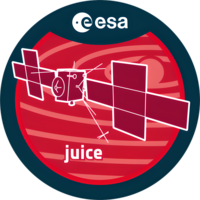
Back مستكشف أقمار المشتري الجليدية Arabic موسكتشيف د لأقمار لمڭلاصية د جوپيتر ARY JUICE Bulgarian Jupiter Icy Moon Explorer Catalan Jupiter Icy Moons Explorer Czech Jupiter Icy Moons Explorer Danish JUICE (Raumsonde) German Jupiter Icy Moons Explorer Spanish Jupiter Icy Moons Explorer Estonian کاوشگر قمرهای یخی مشتری Persian
 Artist's impression of the Juice spacecraft | |||||||||||||||||||||||
| Names | JUICE | ||||||||||||||||||||||
|---|---|---|---|---|---|---|---|---|---|---|---|---|---|---|---|---|---|---|---|---|---|---|---|
| Mission type | Planetary science | ||||||||||||||||||||||
| Operator | ESA | ||||||||||||||||||||||
| COSPAR ID | 2023-053A | ||||||||||||||||||||||
| SATCAT no. | 56176 | ||||||||||||||||||||||
| Mission duration | Cruise phase: 8 years Science phase: 3.5 years Elapsed: 1 year, 2 months and 23 days | ||||||||||||||||||||||
| Spacecraft properties | |||||||||||||||||||||||
| Manufacturer | Airbus Defence and Space | ||||||||||||||||||||||
| Launch mass | 6,070 kg (13,380 lb)[1] | ||||||||||||||||||||||
| Dry mass | 2,420 kg (5,340 lb)[1] | ||||||||||||||||||||||
| Dimensions | 16.8 x 27.1 x 13.7 meters[1] | ||||||||||||||||||||||
| Power | 850 watts from a solar panel ~85 m2 (910 sq ft)[1] | ||||||||||||||||||||||
| Start of mission | |||||||||||||||||||||||
| Launch date | 14 April 2023 12:14:36 UTC [2] | ||||||||||||||||||||||
| Rocket | Ariane 5 ECA | ||||||||||||||||||||||
| Launch site | Centre Spatial Guyanais, ELA-3 | ||||||||||||||||||||||
| Contractor | Arianespace | ||||||||||||||||||||||
| Flyby of Moon | |||||||||||||||||||||||
| Closest approach | 19 August 2024 | ||||||||||||||||||||||
| Flyby of Earth | |||||||||||||||||||||||
| Closest approach | 20 August 2024 | ||||||||||||||||||||||
| Flyby of Venus | |||||||||||||||||||||||
| Closest approach | 31 August 2025 | ||||||||||||||||||||||
| Flyby of Earth | |||||||||||||||||||||||
| Closest approach | 29 September 2026 | ||||||||||||||||||||||
| Flyby of Earth | |||||||||||||||||||||||
| Closest approach | 18 January 2029 | ||||||||||||||||||||||
| Jupiter orbiter | |||||||||||||||||||||||
| Orbital insertion | July 2031 (planned) | ||||||||||||||||||||||
| Orbital departure | December 2034 (planned) | ||||||||||||||||||||||
| Ganymede orbiter | |||||||||||||||||||||||
| Orbital insertion | December 2034 (planned) | ||||||||||||||||||||||
| Orbital parameters | |||||||||||||||||||||||
| Periapsis altitude | 500 km (310 mi) | ||||||||||||||||||||||
| Apoapsis altitude | 500 km (310 mi) | ||||||||||||||||||||||
| |||||||||||||||||||||||
 Juice mission insignia | |||||||||||||||||||||||
The Jupiter Icy Moons Explorer (Juice, formerly JUICE[3]) is an interplanetary spacecraft on its way to orbit and study three icy moons of Jupiter: Ganymede, Callisto, and Europa. These planetary-mass moons are planned to be studied because they are thought to have beneath their frozen surfaces significant bodies of liquid water, which would make them potentially habitable for extraterrestrial life.[4][5]
JUICE is the first interplanetary spacecraft to the outer Solar System planets not launched by the United States and the first set to orbit a moon other than Earth's Moon. Launched by the European Space Agency (ESA), from Guiana Space Centre in French Guiana on 14 April 2023, with Airbus Defence and Space as the main contractor,[6][7] it is expected to reach Jupiter in July 2031 after four gravity assists and eight years of travel.[8][9] In December 2034, the spacecraft will enter orbit around Ganymede for its close-up science mission.[8] Its period of operations will overlap with NASA's Europa Clipper mission, launching in 2024.
- ^ a b c d "NASA – NSSDCA – Spacecraft – Details". NASA Space Science Data Coordinated Archive. Archived from the original on 10 November 2021. Retrieved 16 April 2023.
 This article incorporates text from this source, which is in the public domain.
This article incorporates text from this source, which is in the public domain.
- ^ "European Space Agency: Blast off for Jupiter icy moons mission". BBC News. 14 April 2023. Archived from the original on 14 April 2023. Retrieved 14 April 2023.
- ^ "Juice, exploring Jupiter's icy moons". The Planetary Society. Retrieved 30 April 2023.
- ^ Clark, Stuart (5 March 2023). "'It's like finding needles in a haystack': the mission to discover if Jupiter's moons support life". The Guardian. Archived from the original on 7 March 2023. Retrieved 7 March 2023.
- ^ "ESA—Selection of the L1 mission" (PDF). ESA. 17 April 2012. Archived (PDF) from the original on 16 October 2015. Retrieved 19 April 2012.
- ^ "ESA's Juice lifts off on quest to discover secrets of Jupiter's icy moons". ESA. Archived from the original on 14 April 2023. Retrieved 16 April 2023.
- ^ "JUICE. Searching for life on Jupiter's icy moons". www.airbus.com. 27 October 2021. Archived from the original on 13 April 2023. Retrieved 16 April 2023.
- ^ a b "Juice's journey and Jupiter system tour". ESA. 29 March 2022. Archived from the original on 24 September 2022. Retrieved 3 April 2022.
- ^ "JUpiter ICy moons Explorer (JUICE)". NASA Space Science Data Coordinated Archive. NASA. 28 October 2021. Archived from the original on 10 November 2021. Retrieved 10 November 2021.
© MMXXIII Rich X Search. We shall prevail. All rights reserved. Rich X Search